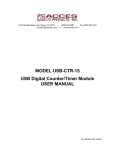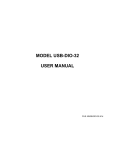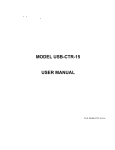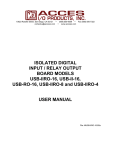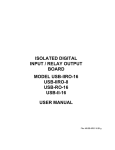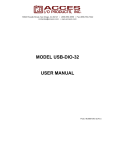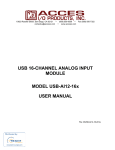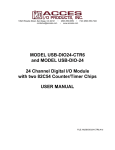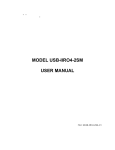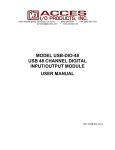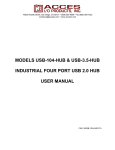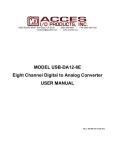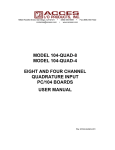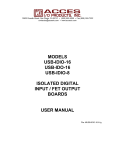Download MODEL USB-CTR-15 USB Digital Counter/Timer
Transcript
10623 Roselle Street, San Diego, CA 92121 y (858) 550-9559 y Fax (858) 550-7322 [email protected] y www.accesio.com MODEL USB-CTR-15 USB Digital Counter/Timer Module USER MANUAL file: MUSB-CTR-15.B2 Notice The information in this document is provided for reference only. ACCES does not assume any liability arising out of the application or use of the information or products described herein. This document may contain or reference information and products protected by copyrights or patents and does not convey any license under the patent rights of ACCES, nor the rights of others. IBM PC, PC/XT, and PC/AT are registered trademarks of the International Business Machines Corporation. Printed in USA. Copyright 2005, 2006 by ACCES I/O Products Inc, 10623 Roselle Street, San Diego, CA 92121. All rights reserved. WARNING!! ALWAYS CONNECT AND DISCONNECT YOUR FIELD CABLING WITH THE COMPUTER POWER OFF. ALWAYS TURN COMPUTER POWER OFF BEFORE INSTALLING A CARD. CONNECTING AND DISCONNECTING CABLES, OR INSTALLING CARDS INTO A SYSTEM WITH THE COMPUTER OR FIELD POWER ON MAY CAUSE DAMAGE TO THE I/O CARD AND WILL VOID ALL WARRANTIES, IMPLIED OR EXPRESSED. Manual USB-CTR-15 2 Warranty Prior to shipment, ACCES equipment is thoroughly inspected and tested to applicable specifications. However, should equipment failure occur, ACCES assures its customers that prompt service and support will be available. All equipment originally manufactured by ACCES which is found to be defective will be repaired or replaced subject to the following considerations. Terms and Conditions If a unit is suspected of failure, contact ACCES' Customer Service department. Be prepared to give the unit model number, serial number, and a description of the failure symptom(s). We may suggest some simple tests to confirm the failure. We will assign a Return Material Authorization (RMA) number which must appear on the outer label of the return package. All units/components should be properly packed for handling and returned with freight prepaid to the ACCES designated Service Center, and will be returned to the customer's/user's site freight prepaid and invoiced. Coverage First Three Years: Returned unit/part will be repaired and/or replaced at ACCES option with no charge for labor or parts not excluded by warranty. Warranty commences with equipment shipment. Following Years: Throughout your equipment's lifetime, ACCES stands ready to provide on-site or in-plant service at reasonable rates similar to those of other manufacturers in the industry. Equipment Not Manufactured by ACCES Equipment provided but not manufactured by ACCES is warranted and will be repaired according to the terms and conditions of the respective equipment manufacturer's warranty. General Under this Warranty, liability of ACCES is limited to replacing, repairing or issuing credit (at ACCES discretion) for any products which are proved to be defective during the warranty period. In no case is ACCES liable for consequential or special damage arriving from use or misuse of our product. The customer is responsible for all charges caused by modifications or additions to ACCES equipment not approved in writing by ACCES or, if in ACCES opinion the equipment has been subjected to abnormal use. "Abnormal use" for purposes of this warranty is defined as any use to which the equipment is exposed other than that use specified or intended as evidenced by purchase or sales representation. Other than the above, no other warranty, expressed or implied, shall apply to any and all such equipment furnished or sold by ACCES. Manual USB-CTR-15 3 Table of Contents Chapter 1: Introduction .............................................................................................................. 5 Features ................................................................................................................................... 5 Applications ............................................................................................................................ 5 Functional Description ........................................................................................................... 5 Figure 1-1: Block Diagram .................................................................................................. 6 Ordering Guide........................................................................................................................ 6 Model Options ......................................................................................................................... 7 Included with your board ....................................................................................................... 7 Optional Accessories ............................................................................................................. 7 Chapter 2: Installation ................................................................................................................ 8 Software CD Installation......................................................................................................... 8 Installing the Hardware........................................................................................................... 8 Chapter 3: Hardware Details...................................................................................................... 9 Option Selections.................................................................................................................... 9 Figure 3-1: Option Selection Map....................................................................................... 9 USB Connector ....................................................................................................................... 9 LED........................................................................................................................................... 9 DC Power Jack (Optional) .................................................................................................... 10 50 Pin Box Header ................................................................................................................ 10 User Configuration Adapter ................................................................................................. 10 Figure 3-2: User Configuration Adaptor .......................................................................... 10 Figure 3-3: User Configuration Adaptor .......................................................................... 11 Default Configuration Adapter ............................................................................................. 11 Chapter 4: USB Address Information ..................................................................................... 12 Chapter 5: Programming.......................................................................................................... 13 Table 5-1: 8254 index / number scheme map.................................................................. 13 Low Level Reference: ........................................................................................................... 14 Vendor Request 20h: Counter Read.................................................................................... 14 Vendor Request 21h: Counter Mode ................................................................................... 14 Vendor Request 22h: Counter Load .................................................................................... 14 Vendor Request 23h: Counter Mode/Load or Read/Mode/Load........................................ 14 Table 5-2: Counter Mode Control Byte ............................................................................ 14 Chapter 6: 8254 Counter/Timer ............................................................................................... 15 Operational Modes................................................................................................................ 15 Mode 0: Pulse on Terminal Count ....................................................................................... 15 Mode 1: Retriggerable One-Shot ......................................................................................... 15 Mode 2: Rate Generator........................................................................................................ 16 Mode 3: Square Wave Generator ......................................................................................... 16 Mode 4: Software Triggered Strobe..................................................................................... 16 Mode 5: Hardware Triggered Strobe ................................................................................... 16 Chapter 7: Connector Pin Assignments ................................................................................. 17 Table 7-1: 50-Pin Connector Pin Assignments ............................................................... 17 Customer Comments ............................................................................................................... 18 Manual USB-CTR-15 4 Chapter 1: Introduction Features • • • • • • • • • • Fifteen 16-bit Counter-Timers (5 x 8254) High-speed USB 2.0 device, USB 1.1 backwards compatible User Wiring Adaptor card provided for flexible yet easy counter concatenation Standard Configuration Adaptor pre-configured for event counting, frequency measurement, pulse width measurement, or frequency generation Power provided via USB cable Resettable fused +5VDC output Standard 50pin IDC type connector with key Screw Terminal board enables quick connection of signals prior to cable harnessing PC/104 size (3.550 by 3.775 in.) Rugged industrial enclosure Applications • • • • • • • • • • • • • Event counting Frequency measurements Position measurement Pulse counting Pulse-width modulation Pulse generation Home Portable Laptop Education Laboratory Industrial Automation Embedded OEM Functional Description This USB board is an ideal solution for adding portable, easy-to-install counter-timer capabilities to any computer with a USB port. The board is a USB 2.0 high speed device, offering the fastest speed available with the USB bus. It is fully compatible with both USB 1.1 and USB 2.0 ports. The card is plug-and-play allowing quick connect/disconnect whenever you need additional I/O on your USB port. The board features 5 fully-undedicated industry standard 82C54 counters. The I/O wiring connections are via an industry standard 50-pin connector or via a terminal block adapter board. For external circuits, fused +5VDC power is available at the connector. The resettable fuse is rated at 0.5A. In addition to +5V power, a 10MHz output signal provides a reliable timebase for many applications. The board is designed to be used in rugged industrial environments but is small enough to fit nicely onto any desk or testing station. The card is PC/104 size - including the proper mounting holes - and ships inside a steel powder-coated enclosure with an anti-skid bottom. Manual USB-CTR-15 5 Figure 1-1: Block Diagram Ordering Guide • • • • USB-CTR-15 USB-CTR-15E USB-CTR-15-OEM MP104-DIN Enclosure, module and screw terminal board Economy model (no screw terminal board) Board only (no enclosure or screw terminal board) DIN rail mounting provision Manual USB-CTR-15 6 Model Options • • -P -RoHS External power and 120VAC / 9VDC adapter A RoHS version of this product is available, please contact us for details Included with your board • • • • • • • The following components are included in your shipment. Please take the time now to ensure that no items are damaged or missing. USB Counter-Timer Module (installed in enclosure, if not -OEM Option) Screw Terminal Accessory (not included with the -E Option) Software Master CD USB I/O Quick-Start Guide 6 foot USB 2.0 cable User Wiring Adaptor Standard Configuration Adaptor Optional Accessories • • • The following accessories are available that are compatible with this Counter-Timer Module. Ribbon Cable Assembly, various lengths from 12” to 10 feet. Screw Terminal Board, can be mounted on DIN-rail DIN-rail Snap-Track Manual USB-CTR-15 7 Chapter 2: Installation A printed USB I/O Quickstart Guide is normally included and packed with your hardware for shipment. It provides all the straight-forward steps necessary to complete your software and hardware installation. Software CD Installation The software provided with this board is contained on one CD and must be installed onto your hard disk prior to use. To do this, perform the following steps as appropriate for your operating system. Substitute the appropriate drive letter for your drive where you see d: in the examples below. WIN98/Me/2000/XP/2003 1. 2. 3. 4. Place the CD into your CD-ROM drive. The install program should automatically run. If not click START | RUN and type , click OK or press . Follow the on-screen prompts to install the software for this board. Leave the CD in the drive as it may be needed for driver installation once you plug the hardware into the USB port. Installing the Hardware Before installing the adapter, carefully read the OPTION SELECTION section of this manual and configure the adapter according to your requirements. In Windows, the SETUP.EXE program will lead you through the process of setting the options on the board. The setup program does not set the options. These must be set manually by jumpers on the board, within the case of the adapter. Manual USB-CTR-15 8 Chapter 3: Hardware Details Option Selections Refer to the setup programs on the CD provided with the board. Also, refer to the Block Diagram and the Option Selection Map when reading this section of the manual. Figure 3-1: Option Selection Map USB Connector The USB connector is a Type B USB connector and mates with the cable provided. The USB port provides communication signals along with +5 VDC power. The board can be powered from the USB port or, if needed for higher current applications, an external power supply can be used. LED The LED on the front of the enclosure is used to indicate power and data transmissions. When the LED is in an illuminated steady green state, this signifies that the board is successfully connected to the computer and has been detected and configured by the operating system. When the LED flashes continuously, this signifies that there is data being transmitted over the USB bus. Manual USB-CTR-15 9 DC Power Jack (Optional) Please note, not all boards will contain this option. This is an option for high current applications when more current is needed than what your computer can provide on the USB port (typically 500 mA). The DC jack has a 2.00mm post on board and is designed to be used with the 9 VDC AC/DC external power supply that ships with this option. The voltage regulator on board regulates the 9 VDC and provides 5 VDC to the onboard circuitry. When using external power, switch the jumper located near the USB connector to VEXT, otherwise when the jumper is in the VUSB position current is drawn from the USB port (please consult the option selection map for a visual reference). 50 Pin Box Header The 50 pin box header has standard .100" spacing between pins and is keyed to prevent improper connections. It can be used with standard IDC type ribbon cables or the screw terminal board that plugs directly into the header. As shown in the Option Selection drawing, this board contains two 50-pin connectors P2 and P3. The right-angle connector, called "P2", is designed to connect to your field cabling. This connector fits through the aperture in the standard enclosure, and is therefore available cleanly from outside the steel enclosure. The other 50-pin header, called "P3", has an identical pinout, but is not designed for cables. Rather, it is intended that P3 will be used to interconnect the various onboard counters. User Configuration Adapter To assist you in wiring the counters together a small PCB is provided, called the "User Configuration Adaptor". This Adaptor is for you to wire the counter arrangement you need. As shown in the following drawing, two through-hole 0.1" spacing solder pads are provided for each signal from each counter, along with a mating 50-pin header. By connecting wires between holes you can create a permanent wiring adaptor "plug" that installs into P3, and creates the counter wiring scheme your application needs. This User Configuration Adaptor eliminates the need for complex wiring harnesses at P2, and increases the reliability of your system. Figure 3-2: User Configuration Adaptor Manual USB-CTR-15 10 Figure 3-3: User Configuration Adaptor Default Configuration Adapter In addition to the User Configuration Adaptor, a pre-wired "Default Configuration Adaptor" is also provided. This small PCB does not include room for user wiring connections; instead, it comes pre-wired into a very efficient counter scheme, wherein each 8254 (three counters) is configured for common counter-timer tasks. The drawing to the right shows the block diagram for this Default Configuration Adaptor. Much of the software provided assumes this default configuration adaptor has been installed at P3. Manual USB-CTR-15 11 Chapter 4: USB Address Information Use the provided driver to access the USB board. This driver will allow you to determine how many supported USB devices are currently installed, and each device’s type. This information is returned as a Vendor ID (VID), Product ID (PID) and Device Index. The board’s VID is “0x1605", and its PID is “0x8020". The Device Index is determined by how many of the device you have in your system, and provides a unique identifier allowing you to access a specific board at will. Manual USB-CTR-15 12 Chapter 5: Programming This board contains Five 8254 chips. Each 8254 contains 3 16-bit counter/timers and a single control register. This effectively provides 15 individual 16-bit down-counter/timers, but only 5 control registers. Because of this, the counters are referenced by two methods: 8254 number + counter index, or counter number. In the software you will normally use 8254 number+counter index, but it is usually more convenient to use counter number for hardware and wiring considerations. The following table shows the mapping between these two number schemes. 8254 number 0 0 0 1 1 1 2 2 2 3 3 3 4 4 4 counter index 0 1 2 0 1 2 0 1 2 0 1 2 0 1 2 counter number 0 1 2 3 4 5 6 7 8 9 10 11 12 13 14 pins 1-3 4-6 7-9 10-12 13-15 16-18 19-21 22-24 25-27 28-30 31-33 34-36 37-39 40-42 43-45 Table 5-1: 8254 index / number scheme map The driver software provided with the board uses a 32-bit .dll front end compatible with any Windows programming language. Samples provided in Borland C++ Builder, Borland Delphi, Microsoft Visual Basic, and Microsoft Visual C++ demonstrate the use of the driver. The following functions are provided by the driver in Windows. These functions will allow you to operate the counter-timer functionality and board-level functions. For detailed information on each function refer to the .html Driver Manual located in the Win32 directory for this board. unsigned long GetDevices(void ) unsigned long QueryDeviceInfo(DeviceIndex, pPID, pName, pDIOBytes, pCounters) unsigned long DIO_Configure(DeviceIndex, bTristate, pOutMask, pData) unsigned long CTR_8254Mode(DeviceIndex, BlockIndex, CounterIndex, Mode) unsigned long CTR_8254ModeLoad(DeviceIndex, BlockIndex, CounterIndex,Mode, LoadValue) unsigned long CTR_8254ReadModeLoad(DeviceIndex, BlockIndex, CounterIndex, Mode, LoadValue pReadValue) unsigned long CTR_8254Read(DeviceIndex, BlockIndex, CounterIndex, pReadValue) unsigned long CTR_StartOutputFreq(DeviceIndex, CounterIndex, pHz) —Please note, CTR_StartOutputFreq assumes the “Standard Configuration Adaptor” is installed, and may therefore not be useful in your application. Manual USB-CTR-15 13 Low Level Reference: Please note, this information is very low-level, and is generally only of use when writing code for operating systems for which we do not yet provide a high-level driver. Feel free to skip the rest of this chapter if it doesn’t apply to your application. In addition to the Windows driver provided above, the USB bus provides a lower-level alternative method of interfacing with the board. USB defines several standard operations, one of which (“Vendor Request”) is used by this board to control all Counter related functionality. Each USB vendor request has two word-size parameters, Value and Index, plus a lengthed data buffer that can be written to the board or read from the board. The following Vendor Request Codes are used by this board: Vendor Request 20h: Counter Read This request reads the current value in the specified counter. Value: The low byte is the index of the 8254, from 00h to 04h. The high byte is the index of the counter, from 00h to 02h. Note that the high byte is not a mode control byte. Index: Reserved, use 0000h Data Read: 2 bytes, the current value in the counter. Vendor Request 21h: Counter Mode This request puts a counter in the specified mode, but does not load a load value. This can be useful for setting the output value of the counter, without actually making it count. (Mode 0 sets the output low, mode 1 sets it high.) Value: The low byte is the index of the 8254, from 00h to 04h. The high byte is for mode control. Index: Reserved, use 0000h. Data: None. Vendor Request 22h: Counter Load Value: The low byte is the index of the 8254, from 00h to 04h. The high byte is a mode control byte, but only bit 7 and 6 are significant - this function will ignore the other bits). Index: The load value, from 0 to 65535 Data Read: None. Vendor Request 23h: Counter Mode/Load or Read/Mode/Load This request puts a counter in the specified mode, then loads it with the specified load value. It can optionally read the current value in the counter before moding it. See the chapter on the 8254 counter/timer for details on the various modes; the bits shown in the table below as “1" need to remain set. Value: The low byte is the index of the 8254, from 00h to 04h. The high byte is the mode control byte. Index: The load value, from 0 to 65535 Data Read: Either none, or 2 bytes. If 2 bytes are read as part of the request, they will be set to the current value of the counter before the mode. Bit Content 7 6 Counter Index, 0-2 5 1 4 1 3 2 1 Counter Mode, 0-5 0 0 Table 5-2: Counter Mode Control Byte Manual USB-CTR-15 14 Chapter 6: 8254 Counter/Timer This board contains five 82C54 counter(s) that each include three 16-bit counter/timers. The default configuration adaptor comes configured in an optimal module for use as event counters, frequency output, pulse width, and frequency measurement (See Block Diagram). Each counter can be programmed to any count as low as 1 or 2, and up to 65,536, depending on the mode chosen. For those interested in more detailed information, a full description can be found in the Intel (or equivalent manufacturer's) data sheet, provided in the /chipdocs directory on the Software Master CD. Refer to Chapter 5: Programming, and the .html Driver Manual document installed by the Software Master CD for information on using the installed software driver for this board. The following data is provided only for reference, as it is unlikely to be needed when using the provided driver. Please note the block diagram description of how the 9 pins associated with 8254 counters are configured into an optimum counter-timer module on this board. In addition, the driver and firmware on the board requires a full 16-bit load operation; do not select “low-byte only” or “high-byte only” modes for the counters. Additional low-level information on the 82C54 can be found on the Software Master CD in the /chipdocs directory. Operational Modes The 8254 modes of operation are described in the following paragraphs to familiarize you with the versatility and power of this device. For those interested in more detailed information, a full description of the 8254 programmable interval timer can be found in the Intel (or equivalent manufacturers') data sheets. The following conventions apply for use in describing operation of the 8254 : Clock: A positive pulse into the counter's clock input Trigger: A rising edge input to the counter's gate input Counter Loading: Programming a binary count into the counter Mode 0: Pulse on Terminal Count After the counter is loaded, the output is set low and will remain low until the counter decrements to zero. The output then goes high and remains high until a new count is loaded into the counter. A trigger enables the counter to start decrementing. Mode 1: Retriggerable One-Shot The output goes low on the clock pulse following a trigger to begin the one-shot pulse and goes high when the counter reaches zero. Additional triggers result in reloading the count and starting the cycle over. If a trigger occurs before the counter decrements to zero, a new count is loaded. This forms a retriggerable one-shot. In mode 1, a low output pulse is provided with a period equal to the counter count-down time. Manual USB-CTR-15 15 Mode 2: Rate Generator This mode provides a divide-by-N capability where N is the count loaded into the counter. When triggered, the counter output goes low for one clock period after N counts, reloads the initial count, and the cycle starts over. This mode is periodic, the same sequence is repeated indefinitely until the gate input is brought low. This mode also works well as an alternative to mode 0 for event counting. Mode 3: Square Wave Generator This mode operates like mode 2. The output is high for half of the count and low for the other half. If the count is even, then the output is a symmetrical square wave. If the count is odd, then the output is high for (N+1)/2 counts and low for (N-1)/2 counts. Periodic triggering or frequency synthesis are two possible applications for this mode. Note that in this mode, to achieve the square wave, the counter decrements by two for the total loaded count, then reloads and decrements by two for the second part of the wave form. Mode 4: Software Triggered Strobe This mode sets the output high and, when the count is loaded, the counter begins to count down. When the counter reaches zero, the output will go low for one input period. The counter must be reloaded to repeat the cycle. A low gate input will inhibit the counter. Mode 5: Hardware Triggered Strobe In this mode, the counter will start counting after the rising edge of the trigger input and will go low for one clock period when the terminal count is reached. The counter is retriggerable. The output will not go low until the full count after the rising edge of the trigger. Manual USB-CTR-15 16 Chapter 7: Connector Pin Assignments A 50-pin connector provided on the back plate of these boards for I/O connections. Connector pin assignments are listed below. Pin 1 3 5 7 9 11 13 15 17 19 21 23 25 27 29 31 33 35 37 39 41 43 45 47 49 Function Timer 0 Clock Input* Timer 0 Output Timer 1 Gate Input* Timer 2 Clock Input* Timer 2 Output Timer 3 Gate Input* Timer 4 Clock Input* Timer 4 Output Timer 5 Gate Input* Timer 6 Clock Input* Timer 6 Output Timer 7 Gate Input* Timer 8 Clock Input* Timer 8 Output Timer 9 Gate Input* Timer 10 Clock Input* Timer 10 Output Timer 11 Gate Input* Timer 12 Clock Input* Timer 12 Output Timer 13 Gate Input* Timer 14 Clock Input* Timer 14 Output Output From Inverter +5V DC, 0.5A Fused Pin 2 4 6 8 10 12 14 16 18 20 22 24 26 28 30 32 34 36 38 40 42 44 46 48 50 Function Timer 0 Gate Input* Timer 1 Clock Input* Timer 1 Output Timer 2 Gate Input* Timer 3 Clock Input* Timer 3 Output Timer 4 Gate Input* Timer 5 Clock Input* Timer 5 Output Timer 6 Gate Input* Timer 7 Clock Input* Timer 7 Output Timer 8 Gate Input* Timer 9 Clock Input* Timer 9 Output Timer 10 Gate Input* Timer 11 Clock Input* Timer 11 Output Timer 12 Gate Input* Timer 13 Clock Input* Timer 13 Output Timer 14 Gate Input* Input To Inverter Ground 10MHz Signal Output Table 7-1: 50-Pin Connector Pin Assignments *Note: Gate and Clock inputs are pulled up through 10k resistors. Manual USB-CTR-15 17 Customer Comments If you experience any problems with this manual or just want to give us some feedback, please email us at: [email protected]. Please detail any errors you find and include your mailing address so that we can send you any manual updates. 10623 Roselle Street, San Diego CA 92121 Tel. (858)550-9559 FAX (858)550-7322 www.accesio.com Manual USB-CTR-15 18



















